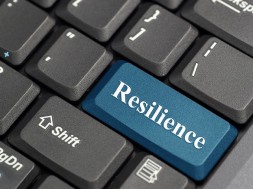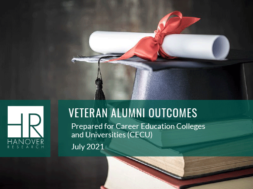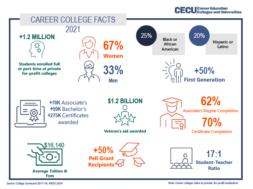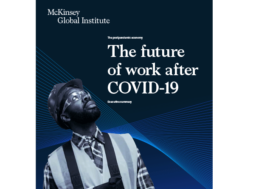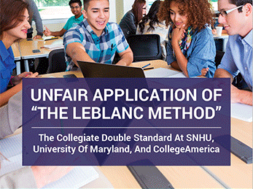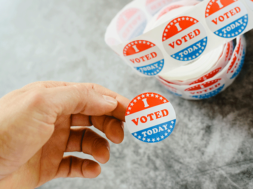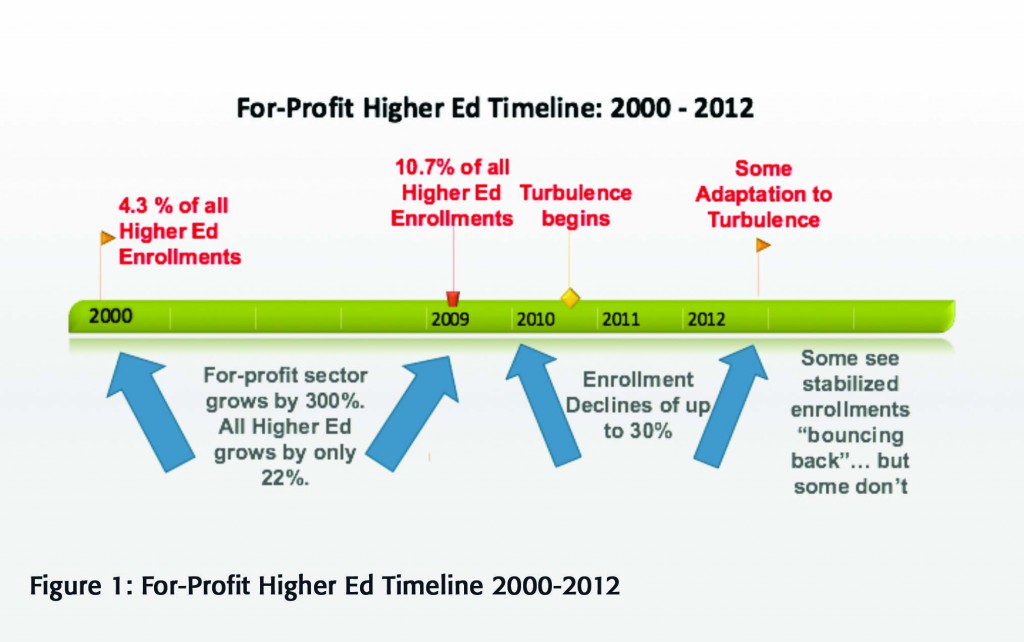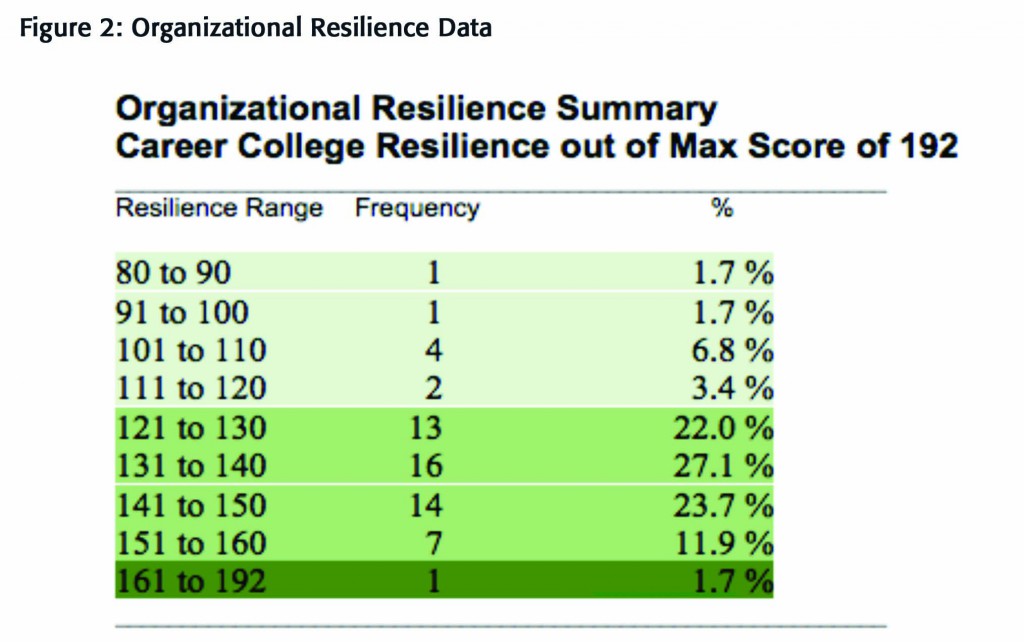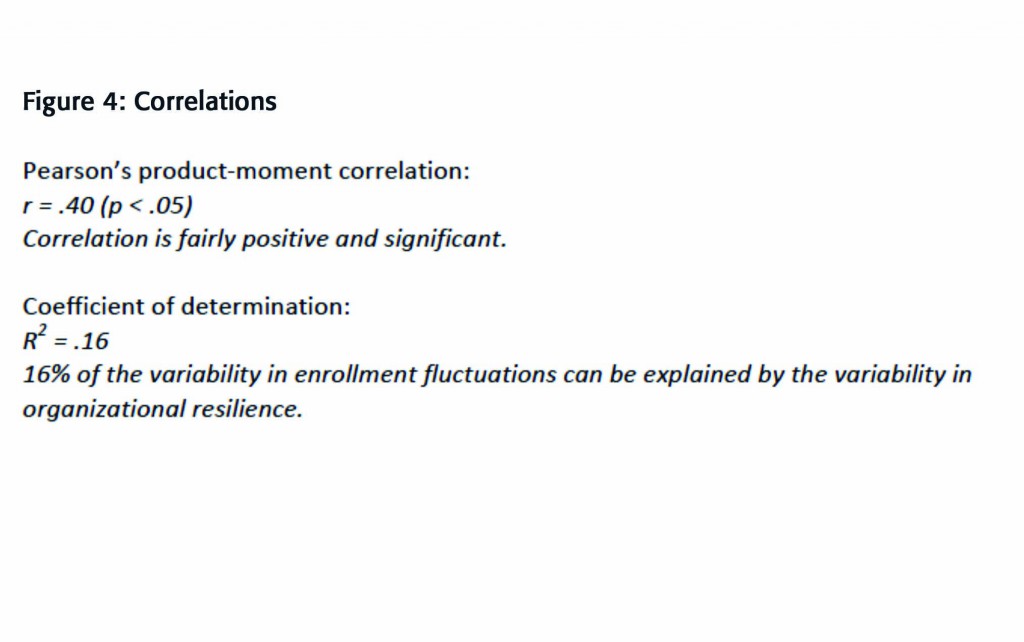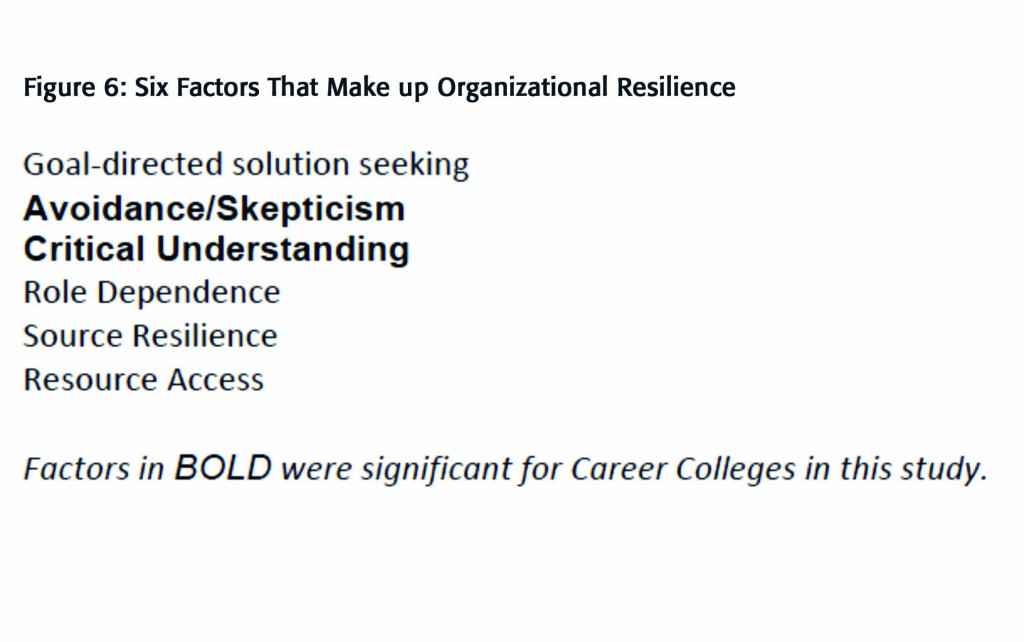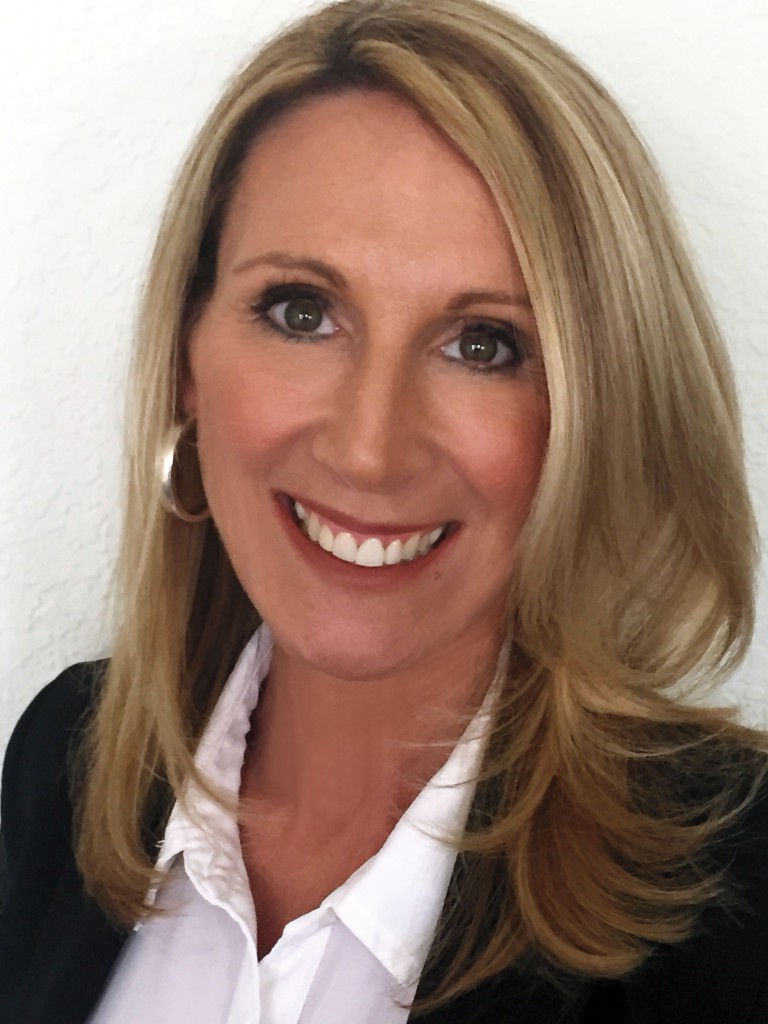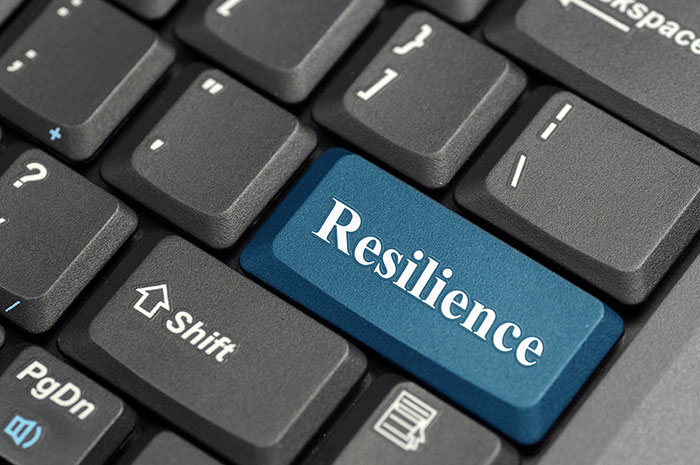
Bouncing Forward: A Study of Career Colleges and their Resilience
Dr. Kathryn Fox Frisbie, MMI Consulting/MMI Placement Verification
I have worked in the career college sector since I was a teenager. Throughout my career I, like many of you, have seen some organizations flourish, and others, sadly close their doors. We are all aware of the turbulent times our sector has gone through, particularly since 2010. I started my research in 2013. At that time, one could not help but notice the enrollment declines that many colleges were experiencing.
What was interesting to me was that, while many schools had declines, some declines were more extreme than others. Their enrollments had fluctuated much more drastically. Other schools showed signs of bouncing back as early as 2012. I asked the question that led to my research: Why did some schools have continued enrollment declines while others saw their enrollment bouncing back? Why did some schools show signs of bouncing back, while others did not?
The ability to bounce back from crisis or withstand great turbulence is called resilience.
Or in the case of my research, organizational resilience (Mallak, 1997). Here are the questions I will attempt to answer in this article:
- What is resilience and what does it mean for our sector?
- Are career colleges resilient?
- Does resilience impact enrollment levels?
- How can we build up our resilience?
Definition of resilience and turbulent environments
Resilience is all about bouncing back. We may be bouncing back from a crisis or may be bouncing back from a turbulent environment. Within the scope of this study, the environment in which career colleges existed starting about 2010 was considered turbulent.
Turbulent environments are very common in industries that have exhibited fast growth. Let’s look at two examples outside of our sector from the recent past. The mortgage industry went through a turbulent environment in 2008 with the housing collapse. This was right after very fast growth. Internet startups went through a time of great turbulence in the early 2000s – right after experiencing very fast growth (Latham & Braun, 2011). Our sector is not unlike those two.
Turbulence in career college sector
We experienced meteoric growth in the first decade of this century. The timeline illustrated in Figure 1 demonstrates what I’m talking about. In 2003, for-profits represented 4.3 percent of all higher education enrollment. This percentage more than doubled by 2009. In that time period, all of higher education grew by 22 percent. The for-profit sector grew by 300 percent.
The year 2010 has been pinpointed as the point in time where true turbulence began (Fain, 2011). That was the year of the GAO audit, gainful employment began to really gain momentum for the Feds, regulatory scrutiny began, and with that, increased media scrutiny. Between 2010-2012 virtually all colleges saw enrollment declines, with the large chains reporting declines of up to 30 percent. By the fourth quarter of 2012, however, some colleges had started to bounce back…but others had not (Fain, 2012).
So the question: was this difference in the rate of bouncing back because of differences in resilience? To answer this question, I did the following:
- First I measured the organizational resilience in a set of career colleges from across the United States.
- Then, I measured how much these colleges had bounced back with their enrollments. I measured how much their enrollments had fluctuated during the two-year period between 2010 and 2012.
- I did a statistical analysis to see if those colleges high in resilience had bounced back with their enrollments by the end of 2012.
If there had been a connection between organizational resilience and enrollment fluctuations, that would mean that schools low in resilience would not have bounced back with their enrollments. Schools high in resilience would have showed signs of bouncing back with their enrollments.
Similar studies to mine have been done in other industries. Someone looked at the resilience of airlines before and after 9/11 by comparing the stock prices before and after that crisis (Gittell, Cameron, Lim, & Rivas, 2006). Another set of researchers looked at the resilience of New Orleans businesses by comparing their financial data before and after Hurricane Katrina (Chewning, Lai, & Doerfel, 2013). Finally, a study has been done comparing the resilience of banks before and after the 2008 crisis (Fungacova & Jakubik, 2013).
Colleges participating in the study
One thing I should point out is the schools that I chose for inclusion in my study. I chose what the academic literature calls “independent career colleges.” They are defined as colleges with five or fewer campuses. The academic literature makes a clear comparison between that size organization and what they call “chains” (Deming, Goldin, & Katz, 2012). I chose this size of school because in my opinion they had been relatively under-represented in the research literature. Also, not included in this study were schools that are predominantly online schools and schools that have cosmetology as their only program. I felt that narrowing my focus in the type of school I was studying would give me better data.
I ended up with 65 participating colleges and 59 usable surveys after some not meeting my criteria were eliminated. These colleges were from 22 different states. All had five or fewer locations, with 35 of them having at least 2 locations. One interesting aspect was the wide fluctuation in their enrollments. The smallest school had 47 students, and the largest had 13,760 (mean of 1330, with standard deviation of 2352, indicating a wide variability in school size).
I only asked “leaders” of organizations to participate in the study (“C” level, president, vice president, or director). I wanted someone who had a general sense of the big picture of the organization. Also, one of the purposes of the study was to identify actions a leader could take to build resilience. So it made sense that I had the leaders completing my questionnaire.
Are career colleges resilient?
To help answer this question, let’s look at the Resilience scores in Figure 2. I used an instrument to measure organizational resilience that had been previously tested for validity and reliability in hospitals (Mallak, 1998). I modified it slightly, with permission from the author, for use in the colleges.
The maximum score on the Resilience Instrument (Mallak, 2006) was 192. The highest score was 181 and the lowest score was 80. These outliers aside, it is interesting to note how most of the schools in this study had moderate to high resilience.
So remember, with a perfect correlation, in a perfect study, those colleges with higher resilience would also have bounced back with their enrollments at a faster rate than those with lower resilience. Let’s see if that happened…
Measuring enrollments
First, consider how I measured enrollments. Remember I was comparing the enrollment at the beginning of the turbulence to a point in time a couple of years later where the turbulence appeared to be stabilizing. In retrospect, there was still much turbulence that occurred after 2012, but remember what triggered this research was the fact that some colleges appeared to be bouncing back by 2012.
Enrollment fluctuation ratio = 2012 enrollment/2010 enrollment
I calculated an Enrollment Fluctuation Ratio by dividing 2012 enrollments by 2010 enrollments. I got these enrollment numbers from IPEDS (using the 12-month enrollment figures). So for example, if School A had 100 students in 2010 and also had 100 students in 2012, the ratio would be 1. If School B had 100 students in 2010 and then 50 students in 2012, the ratio would less than 1, or 0.5. If School C had 100 student in 2010 and 200 students in 2012, the ratio would be 2.
Enrollment data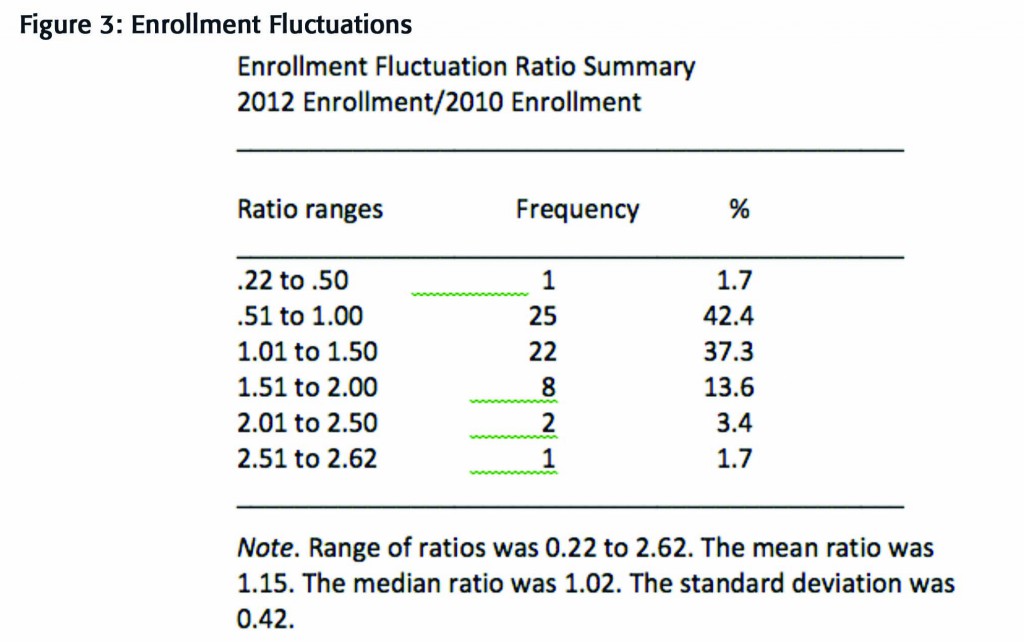
Figure 3 illustrates how the enrollments fluctuated in the 59 participating colleges between 2010 and 2012. Remember a ratio of 1.0 means there was neither an increase nor a decrease in enrollments. The median ratio was 1.02, which means about half had enrollment increases and half had decreases. Specifically, it was skewed more toward increases; while 25 colleges had declines from 2010 to 2012, over 30 had increases. Notice also there are two outliers.
Does resilience impact enrollment levels?
The first step was to see if there was a correlation between resilience of these 59 schools and their enrollment ratios. Thinking back to our college statistics classes, a perfect correlation of 1.0 means that everyone with high resilience would see enrollments increase. Everyone with low resilience would see enrollments decrease. Figure 4 outlines the actual results.
My correlation was not perfect. But it was fairly strong. It was determined to be fairly positive and significant. Keep in mind, correlations just point to relationships, not cause and effect. But we can look at something called the coefficient of determination to decide if any of the variability of enrollments can be explained by the variability in resilience. I was able to determine that 16 percent of the variability in enrollments could be explained by the variability in resilience. While this may seem low, I had very low expectations for this statistic. After all, there are a multitude of variables that can cause enrollments to fluctuate: program mix, tuition levels, the local economy, marketing budget, to name a few. Nevertheless, this question could be answered with some degree of confidence that resilience does contribute to enrollment fluctuations.
One other way of answering this question is to look at the factors that make up resilience and determine if those factors impact enrollment fluctuations. Organizational Resilience has been found to be made up of six individ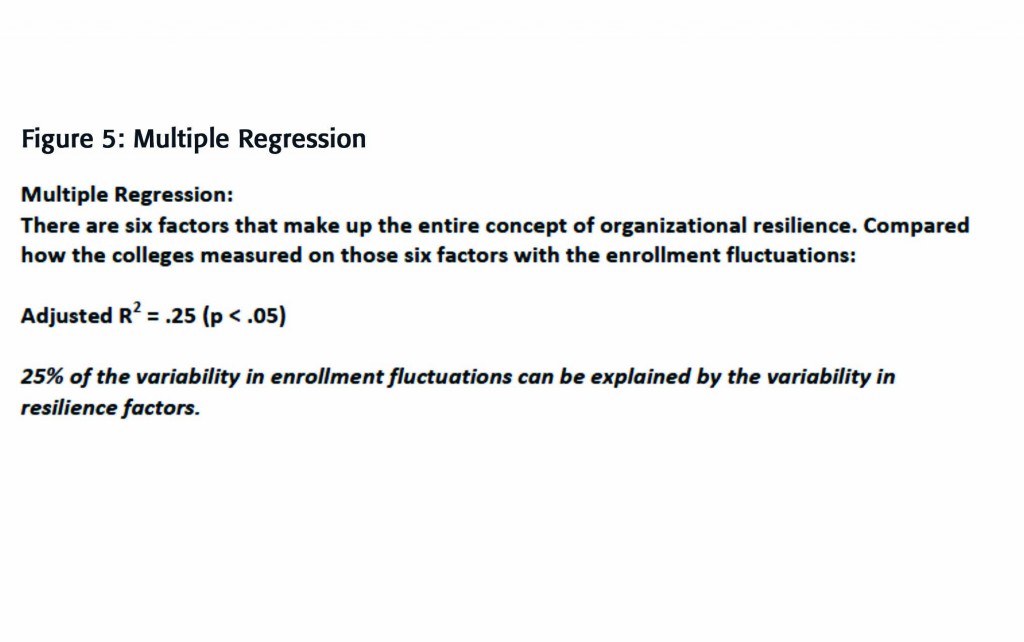 ual factors (Mallak, 1998). We are going to be looking at those six factors shortly, but for now think of it as different pieces of a puzzle that fit together to make up resilience. When I ran a multiple regression on these six factors, I came up with a similar conclusion; 25 percent of the variability in enrollments could be explained by the variability in these individual resilience factors (See Figure 5).
ual factors (Mallak, 1998). We are going to be looking at those six factors shortly, but for now think of it as different pieces of a puzzle that fit together to make up resilience. When I ran a multiple regression on these six factors, I came up with a similar conclusion; 25 percent of the variability in enrollments could be explained by the variability in these individual resilience factors (See Figure 5).
Improving our resilience
Now that we know that resilience has some impact on enrollment fluctuations, we are led to the next question: How can we build up our resilience? It’s important to understand that resilience is a concept that is made up of different factors. Resilience, in itself is not within anyone’s control, but the factors that make up resilience are definitely within our control.
Consider a different concept as an illustration. Let’s look at the concept of health. In itself, we can say we are going to make ourselves healthier. But in order to do that we have to change the factors that contribute to our health: exercise more, eat the right foods, and stop smoking. Resilience is the same. We can say we are going to make our colleges more resilient, but to do that we have to change the factors that make up resilience.
The six factors that make up resilience can be found in Figure 6. I won’t get into these in detail, but I will be delving in to those two concepts in bold: avoidance/skepticism and critical understanding. In the original research about organizational resilience, the organizations used were hospitals. It was found that all six of these factors heavily contributed to resilience (Mallak, 1998). In other words, change these six factors, and the resilience of the hospitals would likely improve.
With the 59 colleges in this study, it was found that only the two factors in bold were significant. In other words, we would have the most impact on changing resilience if we focus on avoidance/skepticism and critical understanding, and would see very little movement in resilience if we focused on the other four. So let’s look at the two factors in which it seems, at least for the colleges in my study, we can focus on improving in order to build up our resilience.
Avoidance/skepticism
The first significant factor is called avoidance/skepticism. The best way of thinking about this factor is to think about obtaining a healthy balance with your willingness to take risks. On one end you could be too timid to make any decisions. On the other end, you jump in to taking risks too quickly. On that end of the scale, those risk-takers tend to go with the flow. Those risk-takers are more prone to group-think. Groupthink is a common term in business psychology about groups that all tend to think alike, and follow their leader blindly. The most famous example is the Bay of Pigs fiasco under Kennedy’s Presidency (Janis, 1972). Avoidance/skepticism is the healthy balance between timidity and group-think.
It is important to note, those career colleges whose leaders avoided group-think were largely on the upper half of enrollment fluctuations – in other words had little fluctuation and in some cases saw measurable increases in enrollments in that two-year period between 2010 and 2012. Encouraging that healthy balance made them more resilient.
Actionable recommendations
Let’s look at actionable recommendations about avoidance/skepticism. First it’s important to encourage teams to make decisions confidently. Commit to their decisions without being timid. Second, it is critically important to avoid having yes-men around you. Yes-men are the first sign of group think. You want someone to challenge you, to question your decisions. And your team needs to feel comfortable in challenging you in that way. It is striving for that healthy balance that I’m talking about.
Critical understanding
The second factor that was significant for this study was critical understanding. This simply means ensuring that the members of your team understand the big picture. Too often our faculty and staff are assigned to their function, and rarely leave the confines of that silo. Financial aid may know the importance of getting the FAFSA done correctly, but they may not understand the role that timely submission of the FAFSA plays in the overall cash flow for the college. Our admissions team may be focused on a start, but may not know the importance of keeping that student until graduation, and making sure that the graduate is then gainfully employed. Our faculty may see an empty seat and recognize that a student has dropped, but may not see the impact that drop may have on overall graduation rates. When your faculty and staff understand the role they play in the entire life of a student and the overall health of your college, they understand the big picture.
And more than that: the colleges in the study whose leaders consistently taught the big picture had limited enrollment fluctuation, and sometimes saw their enrollments increase. Those college leaders made their teams more resilient by ensuring they understood the big picture.
Actionable recommendations
First, teach your team how they contribute to the life of a student. Teach all faculty and staff the role they play in the overall operations of your college. Second, why not also teach your team the big picture of what is going on in our sector?
Let me give you an example. My firm provides placement verification services for over 50 colleges across the country. We have all sorts of career college clients. I can tell you that those career services teams that understand the role they play in terms of gainful employment as well as accreditation standards have better placement verification results. Time after time. Those career services teams understand the big picture. Those colleges are resilient.
Wrap up
Let’s look at the questions I posed at the beginning of this article. First what is resilience and what does it mean for our sector? Resilience is the ability to bounce back from crisis or turbulence. It is especially meaningful for those colleges that have had enrollment declines during these past few turbulent years.
Are career colleges resilient? I believe I have showed that, for the most part, the colleges in my study have moderate resilience. And they show the capacity to improve their resilience.
Does resilience impact enrollment levels? For the 59 colleges in this study, it can be said that resilience does contribute to enrollment fluctuations. It is one of many contributors, but it definitely is one of them.
How can we build up our resilience? By maintaining the healthy balance in risk-taking.And by teaching our teams the big picture.
You know at the end of the day, what really matters is we survive the turbulent environment in which we’ve been existing for the past six years. I hope I’ve given you a couple of tools to not just bounce back…. but bounce forward.
References
Chewning, L. V., Lai, C., & Doerfel, M. L. (2013). Organizational resilience and using information and communication technologies to rebuild communication structures. Management Communication Quarterly, 27(2), 237-240.
Deming, D. J., Goldin, C., & Katz, L. F. (2012). The for-profit postsecondary school sector: Nimble critters or agile predators? Journal of Economic Perspectives, 26, 139-164. doi:10.1257/jep.26.1.139
Fain, P. (2011, November 11). More selective for-profits. Inside Higher Ed. Retrieved from http://www.insidehighered.com/news/2011/11/11/enrollments-tumble-profit -colleges
Fain, P. (2012, October 26). Phoenix reloads. Inside Higher Ed. Retrieved from http://www.insidehighered.com/news/2012/10 /26/university-phoenix-down-not-out
Fungacova, Z., & Jakubik, P. (2013). Bank stress tests as an informative device for emerging markets: The case of Russia. Czech Journal of Economics and Finance, 63, 87-105. doi:10.2139/ssrn.2009700
Gittell, J. H., Cameron, K., Lim, S., & Rivas, V. (2006). Relationships, layoffs and organizational resilience: Airline industry responses to September 11. Journal of Applied Behavioral Science, 42, 300-329. doi:10.1177/0021886306286466
Janis, I. L. (1972). Victims of groupthink: A psychological study of foreign-policy decisions and fiascoes. Boston, MA: Houghton Mifflin.
Latham, S., & Braun, M. (2011). Economic recessions, strategy and performance: A synthesis. Journal of Strategy and Management, 4, 96-115. doi:10.1108 /17554251111128592
Mallak, L. A. (1997). Scales for measuring resilience in organizations. Kalamazoo: Western Michigan University.
Mallak, L. A. (1998). Measuring resilience in health care provider organizations. Health Manpower Management, 24(4), 148-152. doi:10.1108/09552069810215755
Mallak, L. A. (2006). Resilience instrument. Kalamazoo: Western Michigan University.
DR. KATHY FOX FRISBIE has worked in leadership positions in the career college sector in Canada and the United States for over twenty-five years. It was only natural, therefore, that she chose career colleges as the focus of her dissertational research at Nova Southeastern University. Dr. Frisbie was the recipient of the 2015 Dissertation of Distinction Award for this research. An abridged version of her dissertation on this topic was published in the Journal of Work in June 2016.
Dr. Frisbie is currently Vice President of MMI Consulting/MMI Placement Verification, serving over 50 career colleges and universities across the United States.
Contact Information: Dr. Kathryn Fox Frisbie // Vice President // MMI Consulting/MMI Placement Verification // 972-691-4980 // kathyf@mmicollegeconnection.com // Social Media: https://www.linkedin.com/in/dr-kathy-fox-frisbie-215198b
